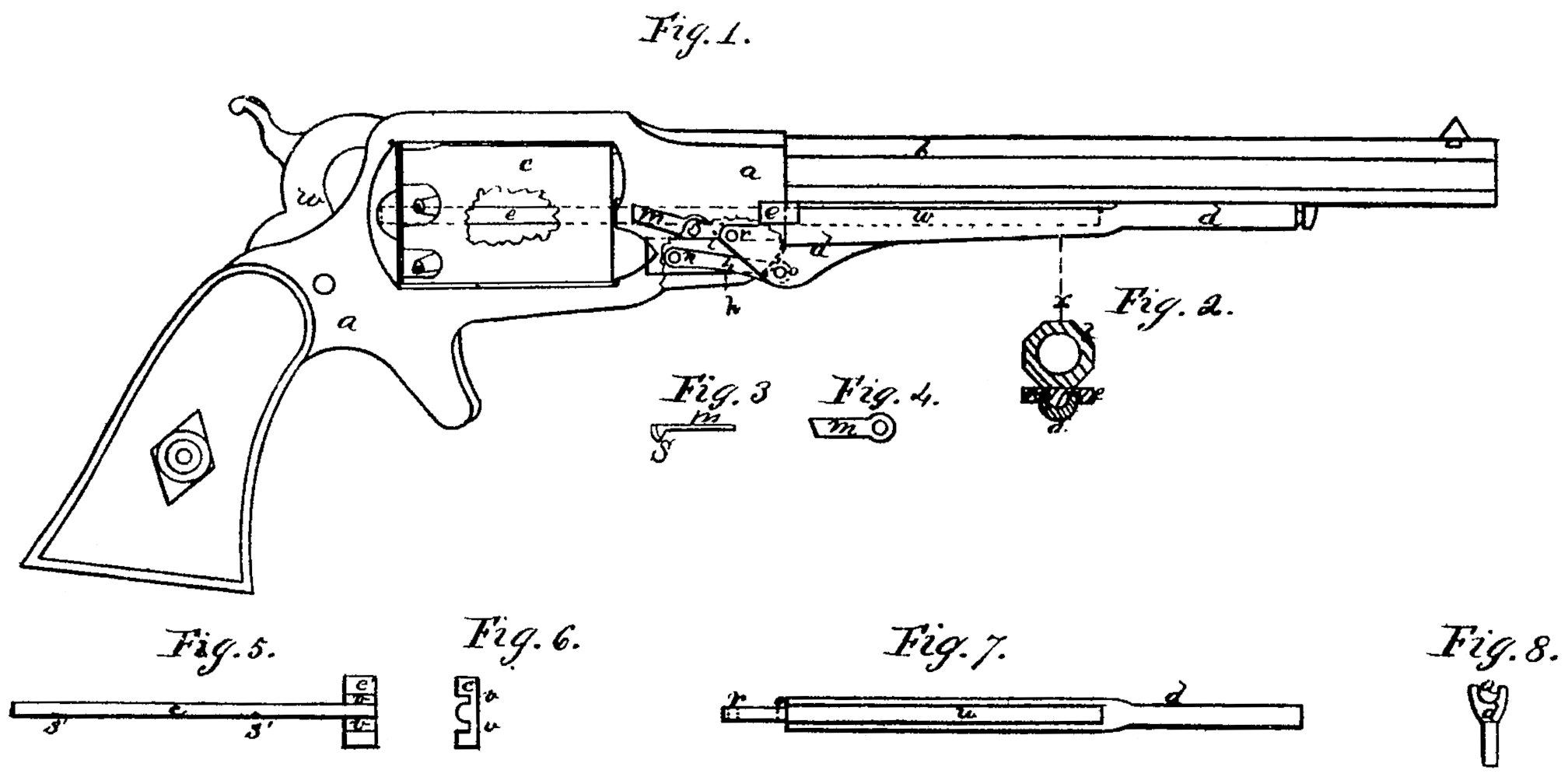US 33932
UNITED STATES PATENT OFFICE.
WM. H. ELLIOT, OF PLATTSBURG, NEW YORK.
IMPROVEMENT IN THE BASE-PIN AND RAMMER OF REVOLVING PISTOLS.
Specification forming part of Letters Patent No. 33,932, dated December 17, 1861.
To all whom it may concern:
Be it known that I, W. H. Elliott, of Plattsburg, in the county of Clinton and State of New York, have invented a new and Improved Mode of Constructing and Arranging the Base-Pin and Lever of Revolving Pistols; and I do hereby declare that the following is a full and exact description thereof, reference being had to the drawings accompanying the same and the letters of reference marked there on, similar letters indicating the same parts in all the figures.
The nature of my invention consists in so constructing and arranging the base-pin and lever of revolving pistols in relation to each other and to the other parts of the pistol that while its symmetry is improved and a greater degree of compactness is attained the base pin may be drawn out and the cylinder removed without disturbing any of the other parts of the pistol thus making it, in these respects superior to other revolvers in which a loading-lever is used.
To enable others skilled in the art to make and use my invention, I will proceed to describe its construction and operation.
Figure 1 is an elevation of my improved pistol. Fig. 2 is a section of my improved pistol, at x, when the base-pin is drawn out. Fig. 3 is a friction-spring for holding the base-pin. Fig. 4 is another view of the same. Fig. 5 is an elevation of the base-pin. Fig. 6 is a section of the same through the head. Fig. 7 is an elevation of the lever. Fig. 8 is a section of the same.
a a represent the frame; b, the barrel; c, cylinder; d, lever; e, base-pin; e’, head of the same; h, link connecting plunger i to the lever; m, friction-spring; n, pivot fastening the link to the plunger; o, pivot fastening the lever to the link; r, pivot fastening the lever to the frame; s, point of spring m, which acts upon the base-pin; s’, notches in the base-pin to receive point s; u, groove cut in the back of the lever to receive the base-pin; v, thin portion of the head each side of the body of the base-pin; w, hammer, located in the center of the frame in the rear of the barrel.
When the base-pin is drawn out for the purpose of removing the cylinder from the frame it occupies the groove in the back of the loading-lever, and its head projects out at each side of the pistol, while the thin portions v v of the head occupy the narrow space between the barrel and the lever. The head is made thicker at its extremities, so as to afford a more comfortable hold for the thumb and finger in handling it. By providing space between the lever and barrel for the base-pin it is unnecessary to disturb the lever in removing the cylinder from the frame. By this arrangement all the difficulties that arise from displacing other parts of the pistol when it is only necessary to remove the cylinder are avoided. These advantages may be had in pistols where side locks are used without providing space between the barrel and lever for the base-pin, as the base-pin in such cases may be drawn out at the rear of the frame; but in my pistol, while I retain the advantage of placing the hammer in the center of the frame behind the cylinder, the base-pin can be passed forward out of the cylinder without first displacing the lever or removing any portion of the frame. By providing the groove in the side of the lever next to the barrel for the reception of the base-pin the form and symmetry of the pistol are at least uninjured, while the strength of the lever, compared with its weight, is increased. Without a groove either in the lever or barrel for the reception of the base-pin, the advantages of removing the cylinder by drawing out the base-pin in front without displacing other parts of the pistol could not be attained without leaving an open space between the lever and barrel equal to the diameter of the base-pin, which would render the pistol less compact, and also seriously injure its appearance.
I do not make the broad claim of so constructing a pistol that the base-pin may be drawn out for the purpose of removing the cylinder from the frame without disturbing other parts of the pistol; nor do I claim: drawing out the base-pin in front for the same purpose when employed with a hammer placed in the center of the frame in the read of the cylinder; but
What I do claim, and wish to have secured to me by Letters Patent, is—
1. So constructing and arranging the base-pin e and lever d in relation to each other and to the barrel that the base-pin may be drawn out in front without first displacing the lever or any portion of the frame, when these devices are employed with a hammer which is located in the center of the frame in the rear of the cylinder, as herein set forth.
2. Providing a groove, u, in lever d, so as to afford space for the reception of the base-pin e as it is passed forward out of the cylinder, as and for the purpose herein specified.
3. Cutting away the projecting portions of the head of the base-pin, as represented at v v, when the base-pin so formed is employed with a grooved lever, d, as and for the purpose set forth.
W. H. Elliot.
Witnesses:
Adriem. O. Mather,
L. L. Mery.

